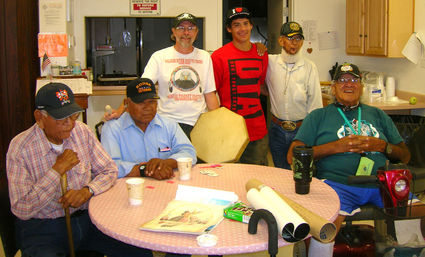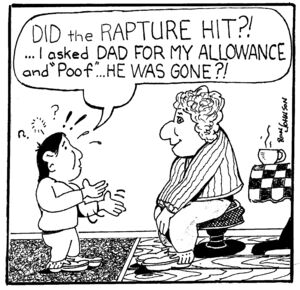The Pine Nut Festival
Time to give thanks for the harvest, family and community
Last updated 12/15/2012 at 2:03pm

Gary Eastty
It was a special privilege for Gary (with white T-shirt) to honor several of the Native veterans with special songs during a luncheon held in their honor during the festival.
“Get back up there and sing another song.” After singing my first song I turned to sit down and she said to me, “Where do you think your going?” I was afraid I had offended her by singing, but she was intimidating and insistent. When I finished with that song and sat down, Judy said to me, “Gary, now you’re a real Paiute.”
This happened in 1986 after my Paiute mentor, Art Cava-naugh, told me I could begin singing with the rest of the singers for the dance. I was very nervous, because people at this rez didn’t know me and had never heard me sing. And this is where Judy Trejo entered my story. She is a well-known singer who had always been polite to me, but never very friendly. After that incident we became fast friends and today I sing some of her songs too.
Mary Ann and I have been attending the Pine Nut Blessing for over 25 years. When living in McDermitt, Nevada, back in the 1980s, it was then that Art and Ethel Cavanaugh, highly respected elders and singers, asked me if I would be interested in learning their traditional round dance songs. I told them I would be honored to do so and began a journey that continues to this day. Long ago I became a recognized singer and am welcomed back each year to sing.
A few years ago one of our Paiute friends told us his story about standing with two elders just after the Ceremony MC announced my name as the next singer:
First Elder: Is that the guy that I’ve heard before?
Second Elder: Yes, he’s been singing for a long time.
First Elder: But, he looks so tibo—“white.”
Second Elder (with a little chuckle): Well, that’s because he is, but we don’t think of him that way, he’s just one of us.

While attending the Blessing we stay with Raphael Bell, Ethel’s son, and we consider each other brothers or in Paiute, he is my Pabe’e or older brother. When departing one year, we had made our rounds saying goodbyes to the people, including Raphael, when he showed up at our house saying, “I just had to come by for one more chance to say how much I’ll miss you.”
For many years the Northern Paiute, Shoshone, Washos and other tribal people have been dancing during the Tuvah Nesootuhi or the Blessing of the Pine Nut. Long ago these people would have gathered first in the spring of the year before the Pine Nut grew to pray to Creator asking for a full harvest throughout the year. Then they would gather again in the fall after the harvesting was done to give thanks for all they received. They also believed the dance would bring healing for those who needed it and participated. Early in our attending the dance, our Paiute companions would tell us, “get up and dance and you will leave here in good health.”

Although there have been many changes to this gathering throughout the years, the general “structure” remains the same. While newer activities take place during the weekend too, a special time on Saturday evening is still given over to the blessing dance. It begins by all other activities being stopped and people gathering in the circle around the pinion pine that has been brought down from the mountains. Usually there are two or three concentric circles numbering over 200 dancers at the beginning of the dance. First, an opening prayer and then someone explains why we are gathering together and what we will be doing and then an Elder is asked to begin the dance with three or four Blessing songs. From that point on other singers are invited to share a song until all the singers have had a chance to do at least one song. During this time pine nuts will be put into a yata, or winnowing basket and carried to the circle to be dropped or “planted” at the dancer’s feet. Following this pine nuts will be passed out to each dancer and singer, and if there are enough that year, even to those who are spectators. Most singers have only one of two songs to share, but several offer to sing as long as dancers remain in the circle.

Today, however, most of the dancers soon leave the circle to head back to the other activities, which are resumed after about an hour of dancing. In the past this dancing would have begun in the early evening and continued into the night until early morning. Today, the primary time frame is only about an hour and a half, although some die hard dancers remain as long as singers sing. We cherish these memories and thank Creator for our Paiute family and friends. These and so many of our experiences reflect the heart and vision we have to serve our Native communities in the spirit of Jesus with the hope of creating a preferred future.
While many challenges confront our Paiute friends and community, we look forward to our annual pilgrimage to McDermott to serve as singers of the songs entrusted to me in support of the people in the love, grace, mercy of Jesus.

